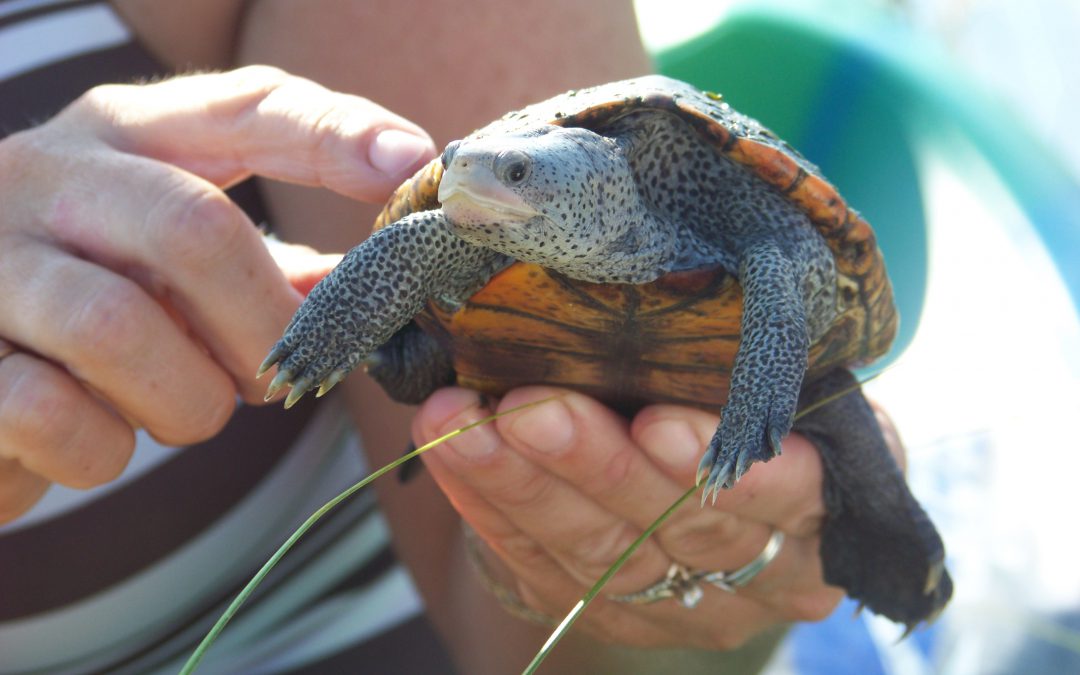
by Rick O'Connor | Dec 22, 2021
2021 Panhandle Terrapin Project Survey Report
Rick O’Connor, Florida Sea Grant, University of Florida / IFAS Extension, Escambia County
SITUATION
The diamondback terrapin (Malaclemys terrapin) is the only resident brackish water turtle in the United States. Ranging from Cape Cod Massachusetts to Brownsville Texas, this turtle is most often found in the salt marsh and mangrove habitats within this range.
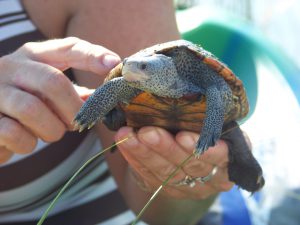
The light colored skin and dark markings are pretty unique to the terrapin.
Photo: Molly O’Connor
Terrapins are medium sized members of the Emydidae family, which includes the cooters, sliders, and box turtles. The carapace length of the larger females is about 10 inches, and she will weigh on average about 20 ounces. Males are smaller, 5-6 inches carapace and about 10 ounces. They are beautifully marked turtles having lighter skin with darker spots or bars. The carapace can have beautiful markings of spots and swirls, many times a brilliant orange in color. Because of this they are popular in the pet trade and illegal pouching is a problem across their range.
There are seven subspecies within this range.
- The northern terrapin ( t. terrapin) can be found from Massachusetts to the Chesapeake Bay area.
- The Carolina terrapin ( t. centrata) is found from the Chesapeake Bay area to the Daytona Beach area of Florida.
- The Florida east coast terrapin ( t. tequesta) is found from the Daytona Beach area to Miami-Dade County.
- The mangrove terrapin ( t. rhizophorarum) is found in the Florida Keys and along the Gulf coast to the Ten Thousand Islands area.
- The ornate terrapin ( t. macrospilota) can be found from the Ten Thousand Island area to Choctawhatchee Bay in the Florida panhandle.
- The Mississippi terrapin ( t. pileata) is found from Choctawhatchee Bay to the Louisiana/Texas state line.
- The Texas terrapin ( t. littoralis) is found along the coast of Texas.
The animal is quite well known in the Chesapeake Bay area where it was harvested in the 19th century as a food source. The popularity of “turtle soup” increased when President Lincoln included it as a local course for state dinners at the White House. The popularity increased the harvest to a point where terrapin farms began to supply the demand, many of these farms were in the south. Eventually the price became too high, and the popularity of the dish waned. At that point research into the animal began in earnest to assess how the commercial harvest had impacted the population. Much of this work was conducted in the early part of the 20th century. By the mid-20th century, a wired crab pot was developed for the harvest of blue crab, a popular fishery in the Chesapeake. Terrapins have a habitat of entering these crab pots and drowning. So, a new threat had emerged. About the same time the automobile was becoming more popular, bridges were being built to connect to barrier islands, and other locations, humans had not visited much before. This activity increased the number of nest predators for terrapins, raccoons being one of the larger problems.
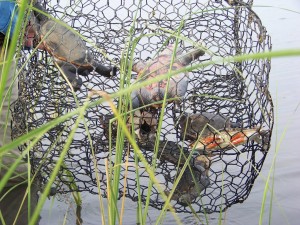
Terrapins in a derelict crab trap (photo: Molly O’Connor)
All of these issues led to more research on terrapin biology and ecology. However, there was one region within their range that very little was known – the Florida panhandle. There were no scientific studies conducted in this part of their range and even their existence there was questioned.
REPSONSE
In response to the question of existence in the Florida panhandle, the Florida Turtle Conservation Trust and the Florida Diamondback Terrapin Working Group, reached out to the Institute of Coastal and Marine Studies (a high school marine science program in Escambia County, Florida). The objective was to have them conduct surveys in suitable terrapin habitat indicating presence/absence of terrapins between Escambia and Franklin Counties. Those surveys began in 2005 and by 2010 had been conducted in all six counties with at least one verified record in each of the six counties (Escambia, Santa Rosa, Okaloosa, Walton, Bay, and Gulf). Terrapins did exist there.
Beginning in 2008 the team began to assess population status. Funding for mark/recapture was not available but a method of assessing relative abundance was being used in Mississippi and was chosen for the Florida panhandle. The method had made several assumptions –
- Each mature female nests every nesting season
- Each nesting female will lay more than one clutch each season but would not lay more than one within a 16-day period.
- The team had identified all terrapin nesting beaches in the region.
Based on this method, surveys were broken into 16-day intervals beginning April 1 and ending on July 1 (peak nesting period). Each track, or depredated nest, was counted and all sign of the track or nest removed so that it would not be recounted within that 16-day period. Each track would then represent a different female and over time the number of nesting females could be determined. Going on the argument that the sex ratio was 1:1 a relative abundance of adult terrapins could be determined. A study conducted in the Big Bend area of Florida by Suarez (Suarez, 2015) suggested the sex ratio was 1:3 in favor of males. A more recent study from the eastern panhandle conducted by Catizone (unpublished) suggests a 1:5 ratio in favor of males. Based on this we could develop a range of relative abundance from 1:1 to 1:5.
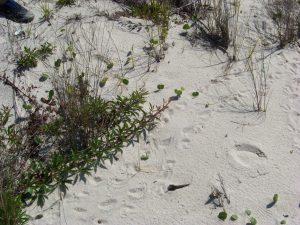
Note the track on this beach.
Photo: Rick O’Connor
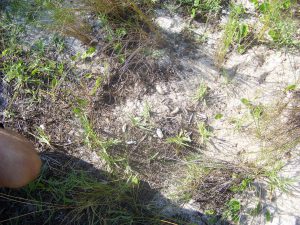
Egg shells indicate a depredated nest.
Photo: Rick O’Connor
Another metric used to measure relative abundance was a 30-minute head count. The team would sit in kayaks within the ponds where adults resided and count the number of heads in that time period. Again, this does not indicate a population but a relative abundance within that location.
Finally, in 2008 the team began to deploy modified crab traps to capture terrapins for a potential mark/recapture study, marking using a scute notching method. The traps were modified so that a captured terrapin would be able to surface and breath. These traps were set in potential adult residing locations for a five-day period beginning on a Monday and ending on a Friday.
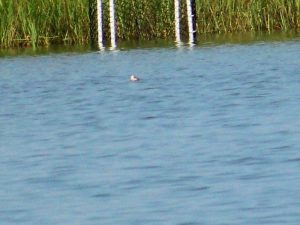
A terrapin swimming near but not entering a modified crab trap.
Photo: Molly O’Connor
The focus of the relative abundance and trapping portions of the project were Escambia and Santa Rosa Counties due to the fact the team resided there.
In 2012, the author left the marine academy and joined Florida Sea Grant. This project was not a high priority in the job description and effort on this waned until no surveys were conducted in 2014. However, in 2015 the author established a citizen science program to continue these surveys and they have done so since. The focus of those surveys has been frequency of occurrence (FOO – the number of surveys where either terrapins, or terrapin sign have occurred) and continuing the relative abundance data collection.
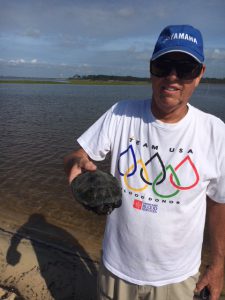
Citizen scientists have been crucial for the success of this project.
Photo: Rick O’Connor
In 2018 the U.S. Geological Survey joined the team. One member of USGS began coordinating citizen science work in the eastern panhandle (Bay, Gulf, and Franklin Counties as well as conducting research in the Gulf County area), and the author began coordinating citizen science work in the western panhandle (Escambia, Santa Rosa, Okaloosa, and Walton Counties). With USGS help some tagging has begun with both PIT and satellite tags.
RESULTS
The 2021 results are from the western panhandle portion of the project.
In the western panhandle during 2021, 263 surveys were conducted by 41 trained volunteers who logged 1832 hours. These surveys occurred in Escambia, Santa Rosa, and Okaloosa Counties. Surveys were conducted at known nesting areas with some occurring at potential new nesting sites. The number of surveys where either terrapins, or terrapin sign, were encountered was 52. This is a frequency of occurrence (FOO) of 20% of the surveys an encounter occurred. The breakdown by county is below.
2021 Data from the Western Panhandle
| County |
# of sites surveyed |
# of surveys |
FOO |
# of heads seen |
Nesting detected |
Relative abundance |
| Escambia |
8 |
86 |
.02 |
1 |
Yes |
8-24 terrapins |
| Santa Rosa |
2 |
79 |
.11 |
0 |
Yes |
4-12 terrapins
2-6 terrapins |
| Okaloosa |
5 |
98 |
.42 |
357 |
Yes |
20-70 terrapins
4-10 terrapins |
| TOTAL |
15 |
263 |
.20 |
358 |
|
|
Three of the eight sites surveyed in Escambia County were known nesting beaches, but evidence of nesting was only found at one. The other five locations were potential nesting sites, but no evidence of nesting was found. Based on these surveys, nesting activity declined in 2021.
Both sites surveyed in Santa Rosa County were known nesting beaches and nesting was detected at both. One site has long term data that, based on this year’s surveys, suggest a decline in relative abundance.
One of the five sites in Okaloosa was a known nesting site. However, evidence of nesting at a additional site was found. An encounter of some kind was logged at four of the five sites surveyed. All of these are relatively new survey sites to the project and relative abundance data is minimal. However, based on these data, the relative abundance is quite high.
Data from 2007 – 2021 for all sites
| County |
# of sites surveyed |
# of surveys |
FOO |
# of nesting beaches found |
| Escambia |
22 |
291 |
.11 |
4 |
| Santa Rosa |
13 |
441 |
.32 |
2 |
| Okaloosa |
12 |
123 |
.36 |
2 |
| Walton |
3 |
4 |
.25 |
0 |
| TOTAL |
50 |
859 |
.25 |
8 |
Since the beginning of the project 859 surveys have been conducted in the four counties of the western panhandle and terrapins have been encountered 25% of the time. Of the 50 sites surveyed, 8 (16%) of those have found nesting activity.
Objective 1 has been completed. There are terrapins in the Florida panhandle.
Objective 2 – the relative abundance – is still not completely understood. There was a significant decrease in encounters when the citizen science project began in 2015.
The citizen science effort the FOO was much higher and increased annually. The citizen science effort began in 2015 and the FOO was much lower but increased annually as well. It is believed that the cause of this decline is ability for volunteers to find terrapins, terrapin heads, or evidence of nesting. It is believed the volunteers are getting better and that the data will eventually provide better information on terrapin abundance.
DISCUSSION
Objective 1 has been answered. There are terrapins in the Florida panhandle.
Objective 2 is still not understood. It is believed the higher FOO between 2007 and 2011 was probably due to the ability of the volunteers to detect terrapin or terrapin sign. So, it is not known at this time whether the relative abundance of these animals have declined in the western panhandle or not. As the volunteers get better, we will see over time how the numbers change.
The effort of mark/recapture using modified crab traps has not been very effective. Traps have been deployed with much effort at four sites with very little success. That portion of the project has been suspended while searching for a better method of capture.
At two of the long-term monitoring sites, the relative abundance data suggests a decline in terrapins at those locations. However, as mentioned, confidence in the relative abundance data needs to increase before any strong conclusions can be drawn. These data do suggest small populations at all locations, between 20-50 animals. The citizen science effort will continue, and we hope a more robust population study will follow.
ACKNOWLEDGEMENTS
The author would like to thank the students from the Institute of Coastal and Marine Studies at B.T. Washington High School for assistance developing and conducting the early portion of this project.
Tom Mann from the Mississippi Department of Wildlife for the protocol on relative abundance based on nesting activity.
George Heinrich (Florida Turtle Conservation Trust, Florida Diamondback Terrapin Working Group)
Dr. Joe Butler (University of North Florida, Florida Diamondback Terrapin Working Group)
Dr. Andy Coleman (Birmingham Audubon Society, Gulf Coast Diamondback Terrapin Working Group)
Dr. Thane Wibbels (University of Alabama Birmingham, Gulf Coast Diamondback Terrapin Working Group)
Dr. Ken Marion (University of Alabama Birmingham, Gulf Coast Diamondback Terrapin Working Group) for their assistance, guidance and advice on this project.
Dan Catizone (U.S. Geological Survey, University of Florida)
Dr. Margaret Lamont (U.S. Geological Survey)
for their assistance, guidance, advice, and supply support.
Bob Pitts (Gulf Islands National Seashore)
Bob Blais (Navarre Beach Sea Turtle Conservation Center)
Jeanna Kilpatrick (Choctawhatchee Basin Alliance)
for taking the lead as county volunteer coordinators as well as surveyors.
And the 40 plus volunteers who have logged thousands of hours surveying sites in the western panhandle. We could not have done this without you.
Submitted:
December 22, 2021.
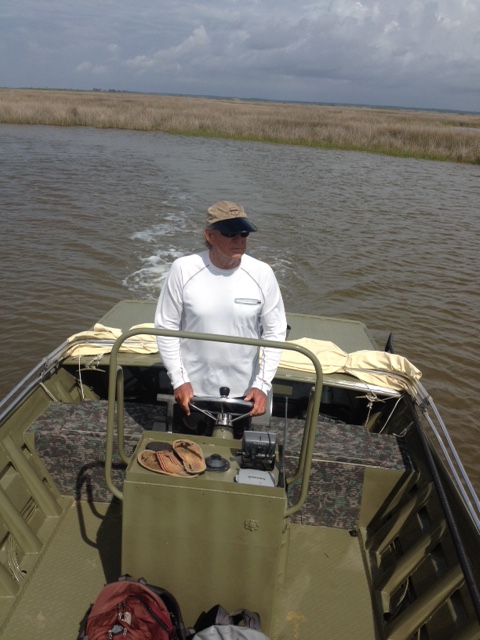
by Rick O'Connor | Dec 17, 2021
Recently I watched a documentary on TV entitled The Loneliest Whale; the search for 52. The title grabbed my attention and so, I checked it out.
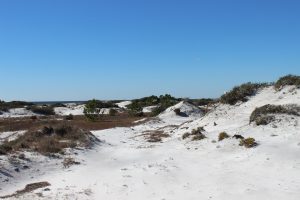
There are many forms of wildlife that are very hard to find in our area. But we continue to look.
Photo: Rick O’Connor
Seems a decade or so ago the U.S. Navy was doing SONAR work in the Pacific between Washington and Alaska and detected a strange sound coming in at 52 hertz. They had not herd this before and would continue to hear it in different locations around the northern Pacific. Their first concern was it was something new from the Russians, but when they showed the graphs and played the recording to a marine mammologist named Dr. Watkins, they found that it was most likely a “biological” – mostly likely a whale.
The problem was that Dr. Watkins had never heard whales calling at 52 hertz. If it was a whale, it was calling a lot – but no other whales were answering. Hence the name “the loneliest whale”. If it was a whale, and no others would talk to it, it was kind of sad. But who was this whale? What kind was it?
Word of the loneliest whale spread around the world and many humans made a connection to this animal, possibly because of their own disconnect with their own species. Stories and ballads were written, and people began to feel for the poor animal that apparently had no friends.
This story caught the attention of a documentary film maker who was interested in finding “52”, as the whale became known. He solicited the help of other marine mammologists; Dr. Watkins had died. According to those marine mammologists, this was going to be VERY difficult. It is hard enough to find just a pod of whales in the open Pacific, much less a specific pod with a specific individual. But they were excited about the challenge of finding this one animal, “52”, and off they went.
As I was watching this documentary it reminded me of my own search here near Pensacola. In 2005, I was asked by members of state turtle groups if I could search to see if diamondback terrapins lived in the western panhandle. This turtle’s range is from Cape Cod Massachusetts to Brownsville Texas, but there were no records from the Florida panhandle. Did the animal exist there? I was running the marine science program at Washington High School at the time and thought this would be a good project for us. So, we began.
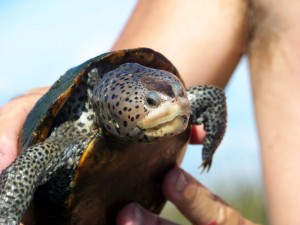
Mississippi Diamondback Terrapin (photo: Molly O’Connor)
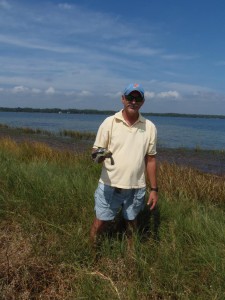
This small turtle can be held safely by grabbing it near the bridge area on each side.
Photo: Molly O’Connor
The students researched terrapin biology and ecology to determine the locations with the highest probability of finding, and we searched. I quickly found that the best time to search for terrapins was during nesting in May and June, and that the worst time to do a project with high school seniors was May and June. So, the project fell on my wife and me. For two years we searched all the “good spots” and found nothing. We placed “Wanted Poster’s” at boat ramps near the good spots with only calls about other species of turtles, not the terrapin.
Then one day in a call came in from a construction worker. Said he had seen the turtle we were looking for. For over a year we had been chasing “false calls” of terrapins. So, I was not overly excited thinking this would be another box turtle or slider. I asked a few questions about what he was looking at and he responded with “you’re the guy who put the wanted poster up correct? – well your turtle is standing next to the poster… it’s the same turtle”. Now I was excited. We did some surveys in that area and in 2007 saw our first terrapin! I can’t tell you how exciting it was. Two years of searching… at times thinking we might work on another project with a different species that actually exists… reading that the diamondback terrapin is like the Loch Ness monster – everyone talks about them, but no one has ever seen one. And there it was, a track in the sand and a head in the water. Yes Virginia… terrapins do exist in the Florida panhandle. The excitement of finding one was indescribable.
We were hooked. We now had to look in other counties in the panhandle, and yes, we found them. As I watched the program of the marine mammologists searching for “52” I could completely relate.
Today, as a marine educator with Florida Sea Grant, I train others how to do terrapin surveys and searches. I let them know how hard it is to find them and to not get disappointed. When they do see one, it will be a very exciting and fulfilling day. Our citizen science program has expanded to searching for other elusive creatures in our bay area. Bay scallops, which are all but gone however we do find evidence of their existence and spend time each year searching for them. In the five years we have been searching we have found only one live scallop, but we are sure they are there. We find their cleaned shells on public boat ramps – by the way, it is illegal to harvest bay scallops in the Pensacola Bay area. Another we are searching for is the nesting beaches of the horseshoe crabs. This is another animal that basically disappeared from our waters but are occasionally seen now. It is exciting to find one, but we are still after their nesting beaches and the chase is on.
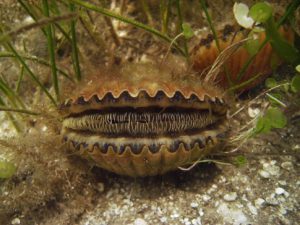
Bay Scallop Argopecten irradians
http://myfwc.com/fishing/saltwater/recreational/bay-scallops/

Horseshoe crabs breeding on the beach.
Photo: Florida Sea Grant
I love the challenge of searching for such creatures. If you do as well, we have a citizen science program that does so. You can just contact me at the Escambia County Extension Office to get on the training list, trainings occur in March, and we will get you out there searching. As for whether they found “52”, you will have to watch the program 😊
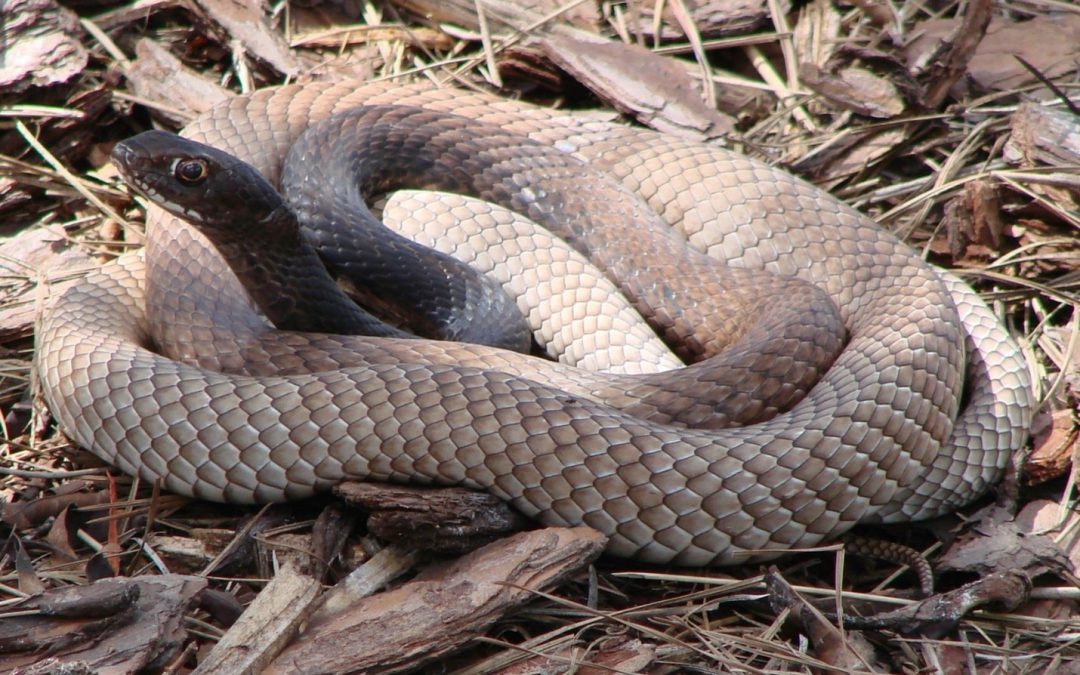
by Rick O'Connor | Dec 10, 2021
By Dr. Steve A. Johnson, Department of Wildlife Ecology & Conservation, University of Florida
As I was pondered writing about snakes for Panhandle Outdoors, an email notification appeared on my computer screen: “Snake in Pensacola Bay”. As a State Extension Specialist with the University of Florida’s Institute of Food and Agricultural Sciences I receive a lot of email requests to identify snakes and other reptiles. But the subject line of this message really got my attention because most of Florida’s approximately 50 species of native snakes are terrestrial, and with few exceptions, our aquatic snakes only occur in freshwater. Florida is home to one snake that lives in the marine environment, the Saltmarsh Watersnake (Nerodia clarkii), but they inhabit shorelines and rarely stray far from cover. And sea snakes are only found the Pacific Ocean basin—they do not naturally occur in the Gulf of Mexico.
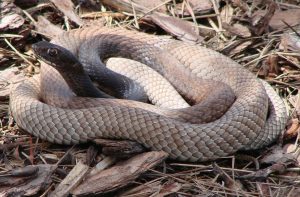
Eastern Coachwhips are long and thin, and most adults have a dark head and upper body. The rest of the body is tan or brown and the scale pattern on the tail resembles a braided bullwhip. Photo by Nancy West.
With anticipation I opened the email and viewed the attached images. To my surprise the snake seen by a fisherman who “came across a snake swimming out in the middle” of Pensacola Bay was an Eastern Coachwhip (Masticophis flagellum). In my almost 20 years with the University of Florida I’ve been emailed hundreds of times with requests to identify snakes. Although the coachwhip is a fairly common snake in Florida, its rarely the species I’m asked to identify. But I distinctly remember another email about 10 years ago from a gentleman in southeastern Florida who claimed he had killed a deadly Taipan snake, or at least something that looked to him like a Taipan. He told me he had lived in Florida for 30 years and knew how to identify snakes, but he had never seen a native snake that looked like this. There are three recognized species of Taipans, they are all native to Australia and are among the world’s most venomous land snakes. However, Florida is the global epicenter for introductions of non-native reptiles, due mainly to imports for the exotic pet reptile trade, so I did not immediately dismiss his assertion of Taipan, but I was highly suspect. Fortunately, the image attached to the email was not a Taipan. But unfortunately, it was an Eastern Coachwhip that he needlessly killed. Coachwhips are not venomous and are certainly not deadly of even dangerous, unless you are a lizard.
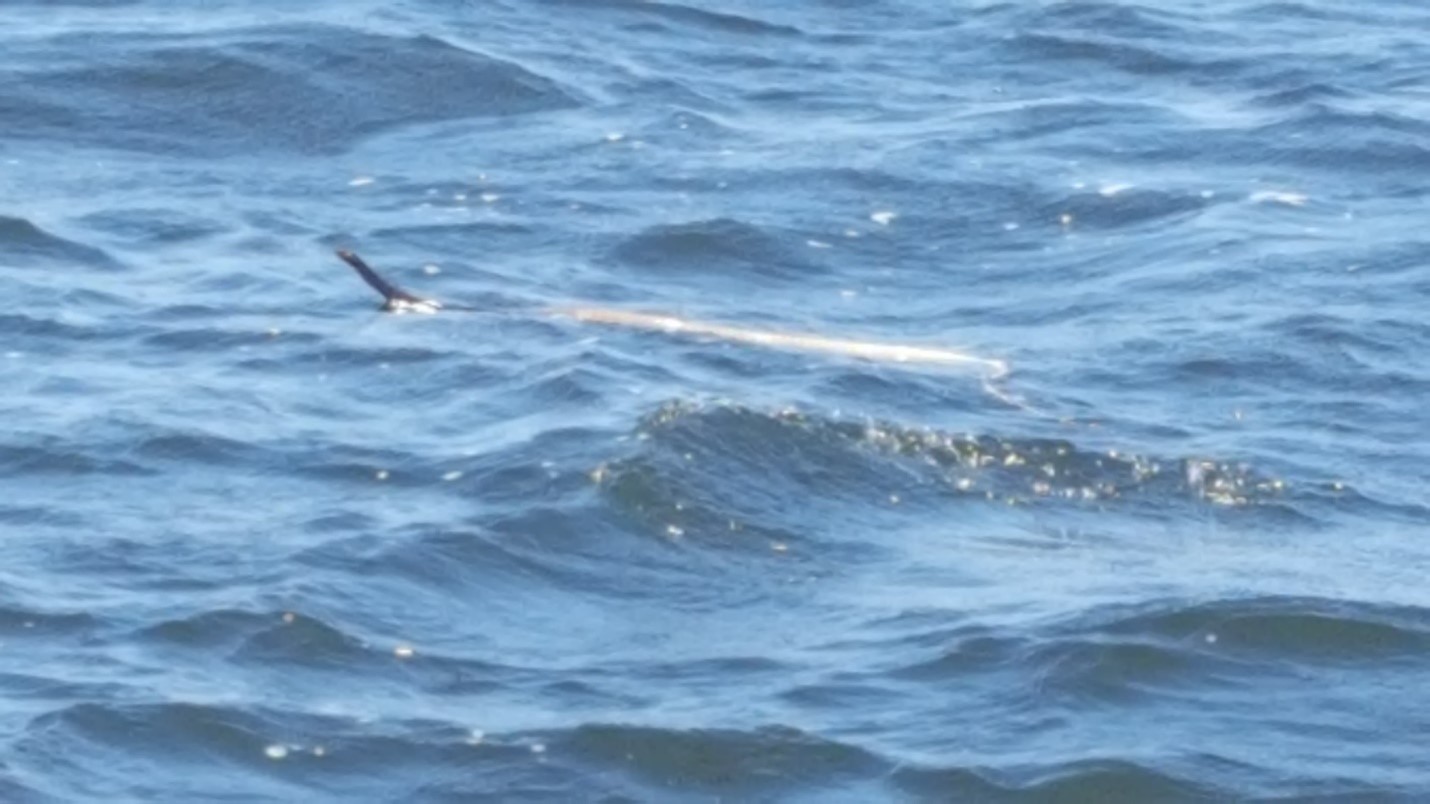
The dark head and upper body followed by a tan color allowed positive identification of this snake in Pensacola Bay as an Eastern Coachwhip. Photo by David Celko.
Coachwhip snakes are closely related to the Black Racer, the common “black snake” of the Southeast. Like racers, coachwhips are long, thin snakes with relatively large eyes. In fact, the Eastern Coachwhip is one of the longest native snakes in North America, reaching a maximum length of 8.5 feet, including the tail. The head and upper body of adult Eastern Coachwhips are usually dark brown or black, fading to brown or tan the rest of the length of their thin body. The scales on their tail resemble the braided pattern of a bullwhip, which is where they get their common name of coachwhip. Young Eastern Coachwhips are also tan colored, but they lack the dark head and upper body. The large eyes are especially obvious in young coachwhips.
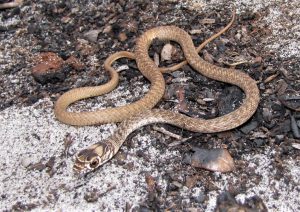
Juvenile Eastern Coachwhips are quite thin and have large eyes. They lack the dark-colored head and upper body of most adults. Photo by Dr. Steve A. Johnson, UF/IFAS.
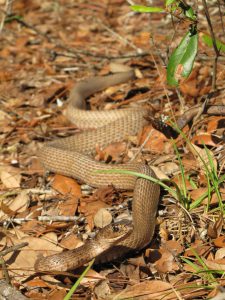
In northern peninsular Florida adult Eastern Coachwhips may lack a dark-colored head and upper body. Photo by Dr. Steve A. Johnson, UF/IFAS.
Eastern Coachwhips actively forage for lizards during the day, and they also eat small mammals, birds, frogs, and even small turtles. While hunting for prey they often move about with their head raised above the ground, visually searching for signs of movement. Eastern Coachwhips have a strong bite, which is how they subdue larger prey—they do no kill prey by constriction like do rat snakes. Coachwhips are fast snakes and can crawl more than 3.5 mph. When startled they often rapidly escape into a burrow or climb into a shrub or small tree. At night they shelter in burrows made mammals as well as the Gopher Tortoise.
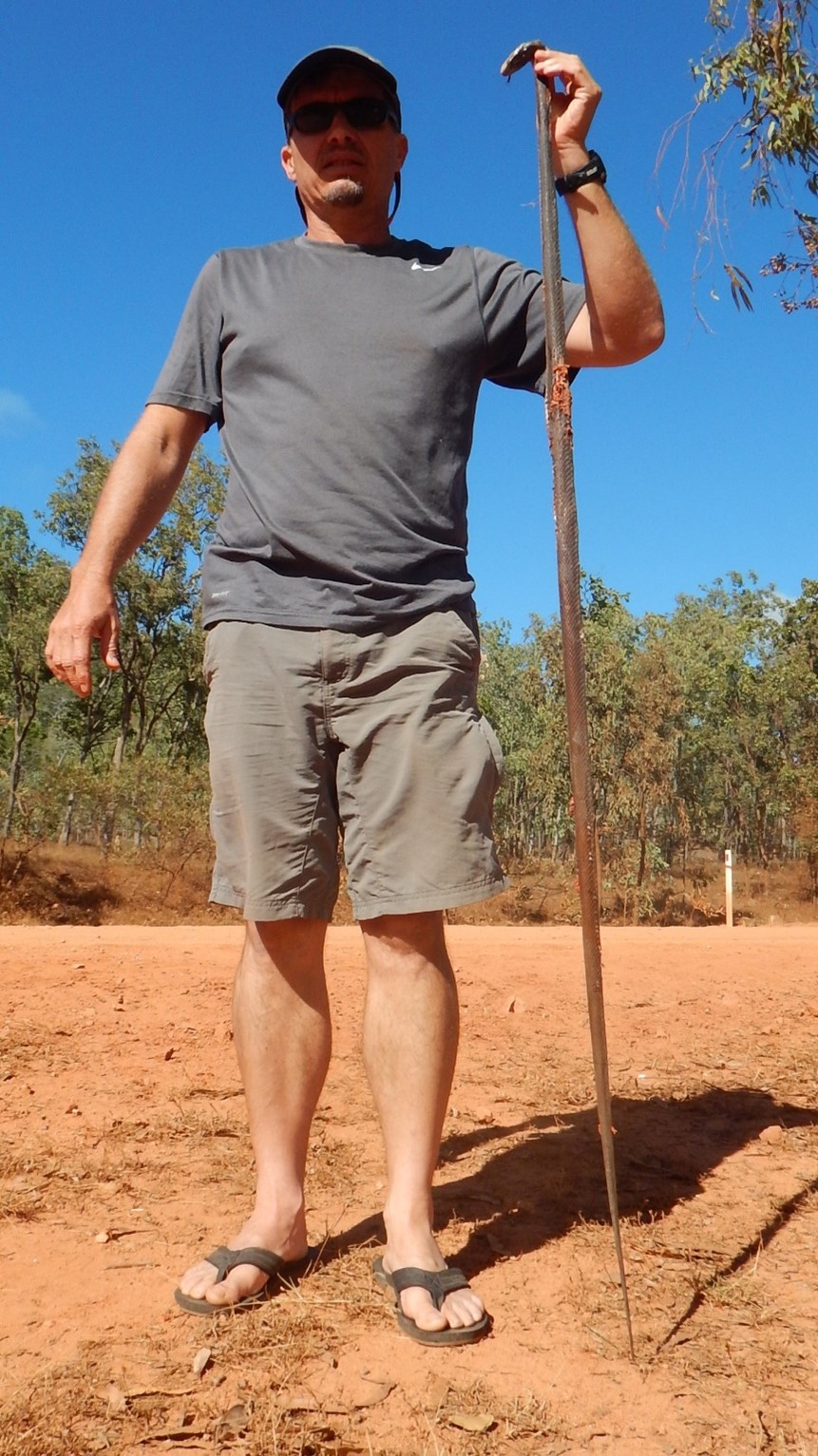
The author holding a (dead) highly venomous Taipan in far north Queensland, Australia. Even in very remote places, roads and vehicles are a source of snake mortality. The Taipan resembles the Eastern Coachwhip of Florida, but taipans only occur in Australia. Photo by Dr. Todd Campbell, University of Tampa.
Like all Florida’s snakes, Eastern Coachwhips are threatened by habitat loss and fragmentation by roads. Coachwhips move around a lot, and often get smashed by vehicles. So do the right thing and “give a snake a brake” the next time you see one attempting to cross a road. And certainly, never kill an Eastern Coachwhip on purpose as they are not venomous and don’t pose any danger to people or pets.

by Carrie Stevenson | Oct 21, 2021
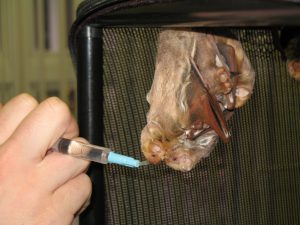
A wildlife biologist feeds an overwhelmed mother bat and her young after they were found on the ground. Photo credit: Carrie Stevenson, UF IFAS Extension
As we enter Halloween season, one of the most popular images of this spooky time of year is that of a bat. The creepy tales of vampire bats and Dracula are enduring and certainly exciting. Unfortunately, many negative connotations exist around this fascinating species. Perhaps you’ve heard they carry rabies, that they will fly into your hair, or that many of them are considered blood-sucking vampire bats?
In fact, there are many benefits to having bats in one’s landscape and neighborhood. The predominant role of bats in our local ecosystem is that of insect predator. A single little brown bat (Myotis lucifugis), which is native to the Florida Panhandle, can eat 1,200 mosquitoes in one hour of feeding! Other species in warmer climates eat fruit and play a major role in reforesting rain forests in Central and South America—after digesting the fruit they leave seeds in their droppings (guano is excellent fertilizer, by the way), helping replant 95% of the very trees they feed upon. Some species feed on nectar, filling the same role as bees and helping pollinate bananas, avocados, cashews, and figs.
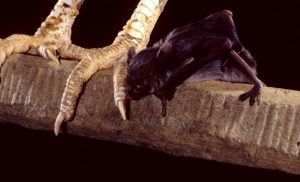
Contrary to popular opinion, vampire bats lap up blood from minor cuts on livestock and do not attack or kill them.
Despite the old saying, bats are not blind and many have excellent vision. However, they do rely heavily on echolocation to sense prey and are extremely accurate hunters. They often fly erratically because they are chasing very small flying insects, so the only reason one would end up in a person’s hair is if a mosquito flew through it with a bat in chase! While vampire bats do exist, there are only 3 out of over 1,000 species of bats that feed on blood, and they all live in Latin America. They typically consume blood from livestock by breaking the skin with their teeth and lapping up blood like a cat drinking milk.
Human contact with bats is rare unless the bats are sick, which is why one found on the ground should be left alone. Rabies transmission from bats accounts for only one death per year in the United States—a statistic much less than that of deaths from dog bites, bee stings, and lighting strikes! In fact, several towns in Texas with the highest populations of bats in the country have recorded zero human bat-transmitted rabies cases. If a bat is obviously injured or has pups with it, most wildlife sanctuaries will take them in and give you special instruction on how to approach them.
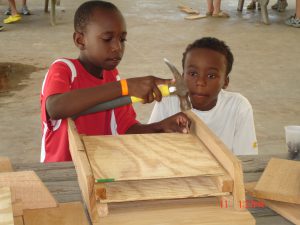
Building bat houses is a great family activity and helps provide much-needed habitat for bats. Photo credit: Carrie Stevenson, UF IFAS Extension
Bat populations are declining in North America due to disease (particularly white-nose syndrome), loss of habitat, and the slow reproductive cycle of bats. However, you can help the world’s only flying mammal by installing a bat house in your yard. Keep in mind that bats attracted to bat houses prefer to be in open areas away from trees (where their predators hide), and the house should be installed at least 12 feet in the air. Bat houses can be purchased or built rather simply—keep an eye out for Extension workshops near you, or visit Bat Conservation International’s website for simple instructions.
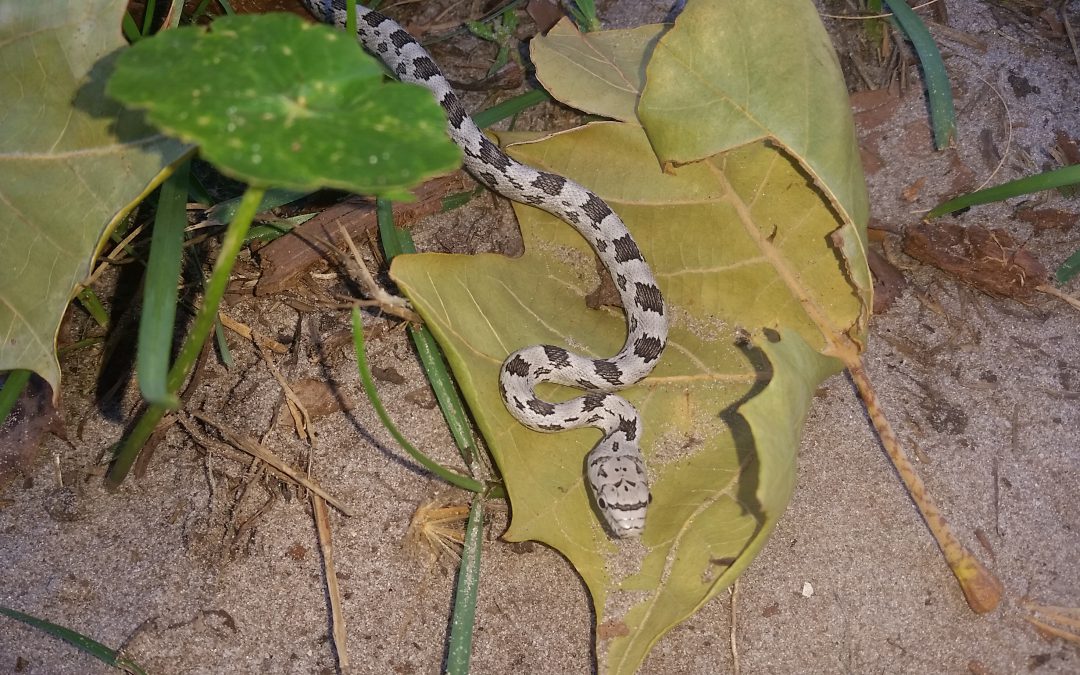
by Erik Lovestrand | Aug 27, 2021
It seems like there has always been a soft spot in my heart for snakes. From a young age, I was fascinated with all reptiles. The rural fabric of where I grew up in Central Florida (think late-1960s) afforded many opportunities for us kids to roam the woods and fields in search of adventure during summer vacation. I vividly remember the occasional eastern hognose snake that we would catch as kids. They were easy to house for a while, as there was no shortage of toads for a food source. This article will focus on some of the common species of snakes in NW Florida and a couple of snake safety tips.
Very likely, one of the first species of snakes most people encounter in North Florida is the gray rat snake (aka oak snake). If you raise chickens, you can greatly reduce the time it takes to enjoy your first encounter. I pull oak snakes out of our nest boxes on a regular basis. I have also encountered some rather large pine snakes in this manner; one with eight egg lumps in its mid-section. These are both harmless, beautiful creatures that can unfortunately make you hurt yourself in a dimly lit coop as you reach in to collect eggs. Another commonly encountered snake in our area is the corn snake, also called a red rat snake. The orange background and dark-red blotches make this one of our most beautiful species. Southern black racers are also a commonly seen species due to their daytime hunting habits. Racers are black on the back with a white chin and very slender for their length. They live up to their name and can disappear in a flash when startled. Two other species regularly encountered here are in the “garter snake” group. The eastern garter snake is one of very few species in our area with longitudinal stripes. They can have a tan to yellowish background color or even a greenish or blue color. The closely related ribbon snake looks similar in color and pattern but has a much slimmer build.

Gray rat snakes are also called oak snakes and are quite common in North Florida
My home county of Wakulla is home to four species of venomous snakes, which include the eastern diamondback rattlesnake, pygmy rattlesnake, coral snake and Florida cottonmouth. However, if you live in other parts of North Florida, you may have five or possibly even six species that are venomous. The copperhead’s range extends into North Florida in a few Counties along the Apalachicola River and the canebrake (or timber) rattlesnake ranges slightly farther south in the peninsula to North-Central Florida. I’ve only seen one canebrake rattlesnake and it was crossing a road on the north side of Gainesville many years ago. Both pygmy rattlers and cottonmouths can be very abundant locally in the right habitats but diamondbacks and coral snakes are less common these days having lost much of their preferred habitats to development.
My best advice for those worried about being bitten by a snake is don’t try to pick one up, and watch where you put your hands and feet. It really is relatively easy to avoid (key word here is avoid) being bitten by a snake. There are many good medical sites on the web with detailed recommendations for snakebite treatment. In the very rare circumstance when someone is envenomated, the best policy is to remain as calm as possible and head for medical attention. Do not cut the skin and try to suck out the venom or apply a tourniquet. These strategies generally cause more harm than good.
I always appreciate the chance to get a look at one of our incredible native snakes when afield, especially if it happens to be one of our venomous species. A big diamondback rattlesnake is an impressive animal to happen on when afield. This appreciation does not mean that I don’t get startled occasionally when surprised, but once that instinctive reaction passes, I can truly appreciate the beauty of these scaly critters.
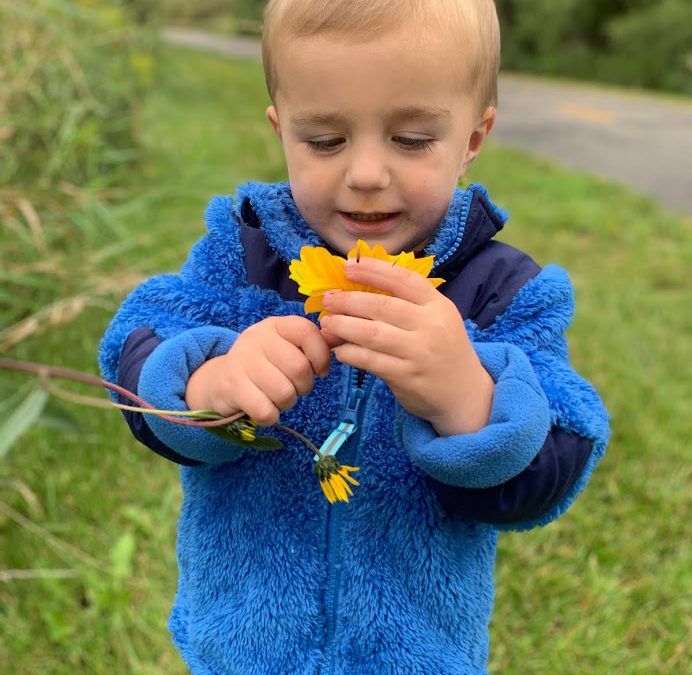
by Molly Jameson | Aug 12, 2021

Article by Rachel Mathes, Horticulture Program Assistant with UF/IFAS Extension Leon County.
By Rachel Mathes
My only brother and his family live in Appleton, Wisconsin. Though I’m only able to see my niece and nephews one or two times a year, we have a deep connection through our love of the outdoors.
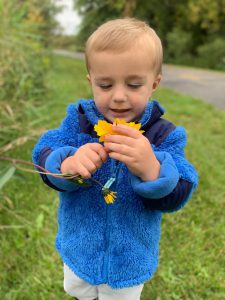
Zach discovering the joy of nature. Photo by Rachel Mathes.
Their middle son, Zachary, is a budding naturalist at just four years old. When I visit them, Zach, his brother Connor, sister Cecilia, and I, load up the wagon and go for walks on the edge of the prairie in their neighborhood. We start our walks looking for scat and signs of wildlife. Because the kids are so close to the ground, they often spot wildlife trails before I do. We talk about what animals may be there, what they eat, and how we can help them.
After each walk, we wind down at home with an iNaturalist session. Zach and his siblings help me choose what animal or plant we think we saw with the help of the app’s nearby suggestions tool. A favorite game we play after all our photos are entered into the app is a game we’ve coined, “where’s that animal?” We use the iNaturalist explore feature to find sightings of exciting creatures like wolves and beavers near their home. The kids have learned that even scientists often don’t see the animals they study, just signs of them.
At age three, Zach learned to identify milkweed with impressive accuracy. I pointed out the plant on a previous trip more than six months earlier and he remembered how to find them. Common milkweed, Asclepias syriaca, is a large leafed species that prefers winters a bit colder than we get here in the Florida Panhandle, but is native in northern states across the Eastern US, including Wisconsin. Zach is often stopping the wagon to scout for monarch caterpillars, finding even the smallest instars and eggs.
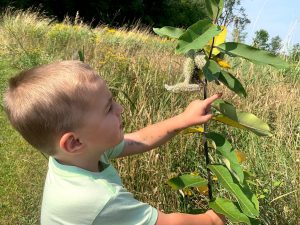
Zach learned to identify common milkweed, Asclepias syriaca, at the age of three. Photo by Rachel Mathes.
When I video call the kids from Florida, Zach is often asking to see my fruit trees, vines, and bushes. He knows that we have very different seasons than Wisconsin when I am eating blueberries in May and he’s still knocking frost off his snow boots. In July, he tells me about the raspberries they find in the woods with their dad. We both get a bit of seasonal berry jealousy. On my last trip we planted thornless blackberries in their garden together. It remains to be seen whether the birds will let the kids have a harvest, but the kids will be excited either way.
Though we may live a thousand miles apart, I know my relationship with my niece and nephews will continue to thrive as they explore the natural world around them. One day, I hope to introduce them to the awe of Florida manatees and alligators. Until then, I will relish the time we get to spend together outdoors in nature and on the phone together. I know that Zachary and his siblings will grow up having respect for the natural world and I hope he always exclaims, “Monarch! Look auntie Rachel, a monarch caterpillar!” on our walks together.
Author: Rachel Mathes, Horticulture Program Assistant with UF/IFAS Extension Leon County.





























